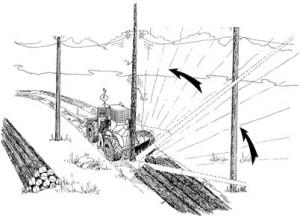BACKGROUND: On a cold (25 degrees F) winter morning in the Appalachians, a cable skidder operator was unchoking his load of pine under an electrical line 28 feet overhead. The landing had been in use in this location for three months, with no prior accidents.
PERSONAL CHARACTERISTICS: The 21-year-old skidder operator had approximately four years of skidding experience. He was wearing a hard hat.
UNSAFE ACT OR CONDITION: While under the power line, the skidder operator began unhooking a drag of six trees that were 50-55 feet long. He could not unhook one of the chokers, because he had attached this choker at a point eight feet from the butt end of the tree, and that tree was on the bottom of the drag.
The operator stood beside the skidder door and operated the winch in an attempt to wrench the tree out of the pile.
ACCIDENT: As the winch pulled in the cable, the mainline suddenly yanked the tree out of the pile and jerked the top upward, with the butt end still caught on the ground. The back of the skidder acted as a leveling device, allowing the tree to spring upright and strike the power line.
INJURY: The power line snapped. Fortunately, the broken ends dropped harmlessly to the ground, and no one was injured. The skidder operator was able to pull away from the downed power line without running over it. However, the logging crew was not able to bring additional wood to the logging deck until after the electric company had reattached the power line.
RECOMMENDATIONS FOR CORRECTION:
- Avoid locating logging decks where there is any potential for equipment or trees to contact power lines.
- Choke logs/trees within the first few feet of the butt. If that is not possible, stop and take time to reposition the choker as soon as possible, to eliminate the potential for the tree to be yanked upward if the butt end catches an object on the ground.
- Stay inside the skidder cab during winching.
 Courtesy of the Forest Resources Association: https://www.forestresources.org/
Courtesy of the Forest Resources Association: https://www.forestresources.org/
